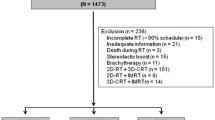Abstract
Due to the unique anatomical location of nasopharynx, tumors of nasopharynx are usually in close proximity to the critical organs. As such, complete resection of NPC is usually not feasible especially for patients with locally advanced diseases. Radiation therapy is the mainstay treatment modality for NPC, and is curative for early-stage disease. For locoregionally advanced disease, combined chemoradiation therapy is the current standard strategy of treatment. Intensity-modulated radiation therapy (IMRT) provides precise and accurate delivery of radiation therapy. Results of dosimetry, retrospective, and prospective clinical studies have confirmed that IMRT significantly improves the treatment outcome in terms of disease control as well as radiation-induced adverse events for NPC, as compared to the conventional radiotherapy (i.e., 3-dimentional conformal radiotherapy or the earlier 2-dimentional radiation). IMRT is the current standard radiation therapy technology for the definitive management of NPC. This chapter aims to detail the clinical evidence of the use of photon-based IMRT for definitive treatment of nonmetastatic NPC, as well as its planning and delivery techniques, and the current recommendation.
Access this chapter
Tax calculation will be finalised at checkout
Purchases are for personal use only
Similar content being viewed by others
References
Bray F, Ferlay J, Soerjomataram I, et al. Global cancer statistics 2018: GLOBOCAN estimates of incidence and mortality worldwide for 36 cancers in 185 countries. CA Cancer J Clin. 2018;0:1–31.
Pathmanathan R, Prasad U, Sadler R, Flynn K, Raab-Traub N. Clonal proliferations of cells infected with Epstein-Barr virus in preinvasive lesions related to nasopharyngeal carcinoma. N Engl J Med. 1995;333(11):693–8.
Liebowitz D. Nasopharyngeal carcinoma: the Epstein-Barr virus association. Semin Oncol. 1994;21(3):376–81.
Hunt MA, Zelefsky MJU, Wolden S, et al. Treatment planning and delivery of intensity-modulated radiation therapy for primary nasopharynx cancer. Int J Radiat Oncol Biol Phys. 2001;49(3):623–32.
Xia P, Fu KK, Wong GW, et al. Comparison of treatment plans involving intensity-modulated radiotherapy for nasopharyngeal carcinoma. Int J Radiat Oncol Biol Phys. 2000;48(2):329–37.
Pow EH, Kwong DL, McMillan AS, et al. Xerostomia and quality of life after intensity-modulated radiotherapy vs. conventional radiotherapy for early-stage nasopharyngeal carcinoma: initial report on a randomized controlled clinical trial. Int J Radiat Oncol Biol Phys. 2006;66(4):981–91.
Kam MK, Leung SF, Zee B. Prospective randomized study of intensity-modulated radiotherapy on salivary gland function in early-stage nasopharyngeal carcinoma patients. J Clin Oncol. 2007;25(31):4873–9.
Peng G, Wang T, Yang KY, et al. A prospective, randomized study comparing outcomes and toxicities of intensity-modulated radiotherapy vs. conventional two-dimensional radiotherapy for the treatment of nasopharyngeal carcinoma. Radiother Oncol. 2012;104(3):286–93.
Lee N, Harris J, Garden AS, et al. Intensity-modulated radiation therapy with or without chemotherapy for nasopharyngeal carcinoma: Radiation Therapy Oncology Group Phase II Trial 0225. J Clin Oncol. 2009;27(22):3684–90. https://doi.org/10.1200/JCO.2008.19.9109.
Lewis GD, Holliday EB, Kocak-Uzel E, et al. Intensity-modulated proton therapy for nasopharyngeal carcinoma: decreased radiation dose to normal structures and encouraging clinical outcomes. Head Neck. 2016;38(Suppl 1):E1886–95. https://doi.org/10.1002/hed.24341. Epub 2015.
Wang L, Hu J, Liu X, et al. Intensity-modulated carbon-ion radiation therapy versus intensity-modulated photon-based radiation therapy in locally recurrent nasopharyngeal carcinoma: a dosimetric comparison. Cancer Manag Res. 2019;11:7767–77.
Lo YM, Chan AT, Chan LY, et al. Molecular prognostication of nasopharyngeal carcinoma by quantitative analysis of circulating Epstein-Barr virus DNA. Cancer Res. 2000;60(24):6878–81.
Lo YM, Chan LY, Chan AT, et al. Quantitative and temporal correlation between circulating cell-free Epstein-Barr virus DNA and tumor recurrence in nasopharyngeal carcinoma. Cancer Res. 1999;59(21):5452–5.
Lin JC, Wang WY, Chen KY, et al. Quantification of plasma Epstein-Barr virus DNA in patients with advanced nasopharyngeal carcinoma. N Engl J Med. 2004;350(24):2461–70.
Chan AT, Hui EP, Ngan RKC, et al. Analysis of plasma Epstein-Barr virus DNA in nasopharyngeal cancer after chemoradiation to identify high-risk patients for adjuvant chemotherapy: a randomized controlled trial. J Clin Oncol. 2018:JCO2018777847. https://doi.org/10.1200/JCO.2018.77.7847. Online ahead of print.
Le QT, Zhang Q, Cao H, et al. An international collaboration to harmonize the quantitative plasma EBV DNA assay for future biomarker-guided trials in nasopharyngeal carcinoma. Clin Cancer Res. 2013;19(8):2208–15.
Author information
Authors and Affiliations
Corresponding author
Editor information
Editors and Affiliations
Rights and permissions
Copyright information
© 2021 Springer Nature Switzerland AG
About this chapter
Cite this chapter
Lee, N.Y., Kong, L., Tam, M., Lu, J.J. (2021). Intensity-Modulated Radiation Therapy for Nasopharyngeal Cancer. In: Ma, J., Lee, N.Y., Lu, J.J. (eds) Nasopharyngeal Cancer. Practical Guides in Radiation Oncology. Springer, Cham. https://doi.org/10.1007/978-3-030-65037-7_5
Download citation
DOI: https://doi.org/10.1007/978-3-030-65037-7_5
Published:
Publisher Name: Springer, Cham
Print ISBN: 978-3-030-65036-0
Online ISBN: 978-3-030-65037-7
eBook Packages: MedicineMedicine (R0)




